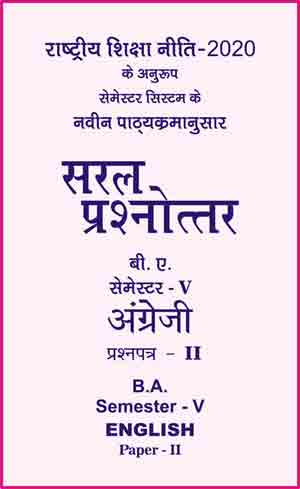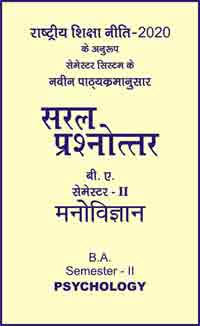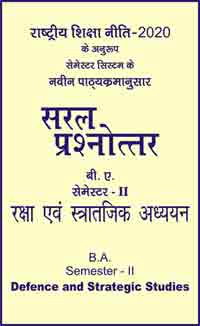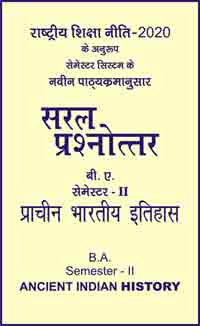|
बी ए - एम ए >> बीए सेमेस्टर-5 पेपर-2 अंग्रेजी बीए सेमेस्टर-5 पेपर-2 अंग्रेजीसरल प्रश्नोत्तर समूह
|
5 पाठक हैं |
|||||||
बीए सेमेस्टर-5 पेपर-2 अंग्रेजी - सरल प्रश्नोत्तर
Question- Discuss the narrative structure of the novel. Why might Morrison have chosen to present the events in a non- chronological way?
Answer-
The events in The Bluest Eye are not presented chronologically; instead, they are linked by the voices and memories of two narrators. In the sections. labeled with the name of a season, Claudia MacTeer's. retrospective narration as an adult contains her childhood memories about what happened to Pecola. The other narrator, the omniscient narrator, then braids her stories into Claudia's season sections, introducing influential characters and events that shape Pecola's life.
Claudia MacTeer is now a grown woman, telling us about certain events that happened during the fall of 1941. She was only a child then, but she remembers that no marigolds bloomed that fall, and she and her friends thought it was probably because their friend and playmate, Pecola, was having her father's baby. She tells us that Pecola's father, Cholly Breedlove, is now dead, the baby is dead, and the innocence of the young girls also died that fall.
We then segue into a lengthy flashback, to Autumn 1940, a year before the fall when no marigolds bloomed. Claudia and her older sister, Frieda, have just started school. That autumn, the MacTeers accept Mr. Henry as a roomer because his rent money will help pay bills. The family soon has another roomer Pecola Breedlove, a young black girl whom county officials place in the MacTeer home after Pecola's father burns the family house down.
Pecola and the MacTeer girls share childhood adventures, and what Claudia remembers in particular is the startling onset of Pecola's puberty when the eleven-year-old girl unexpectedly has her first menstrual period.
The second narrator offers us her memories about Pecola's family. She describes the house where the Breedloves lived (before Cholly burned it down), and she points out the antagonistic relationship between Pecola's parents. We see Pecola and her brother, Sammy, bracing themselves for the ordeal of listening to their mother quarreling violently with their drunken father, Cholly, as he tries to sleep off the effects of the previous night's whiskey.
Against a backdrop of grinding poverty, with her parents locked in an ugly cycle of hostility and violence, Pecola seeks hope in her prayers for beauty, which she feels will lead to her being loved. Each night Pecola fervently prays for blue eyes, sky-blue eyes, thinking that if she looked different pretty perhaps everything would be better. Maybe everything would be beautiful.
Claudia's narrative returns with Winter. She remembers the arrival of Maureen Peal, a new girl in school, whom Claudia calls "the disrupter." Despite Maureen's protruding dog-tooth and the fact that she was born with an extra finger on each hand (removed at birth), Maureen seems to embody everything perfect; she has long, beautiful hair, light skin, green eyes, and bright, clean, pretty clothes. She is enchanting and popular with both the black and white children.
Pecola is not popular. On the playground, Frieda rescues her from a vicious group of boys who are harassing her. Maureen moves quickly and stands beside Pecola, and the boys leave. Maureen then links arms with Pecola and buys her some ice cream. The world seems wonderful until Maureen begins to talk about Pecola's father's nakedness. Claudia and Frieda quarrel with her, and during the squabble, Claudia swings at Maureen but hits Pecola instead. Maureen runs across the street and screams back at the three girls, "I am cute! And you ugly! Black and ugly..." Deeply hurt, Pecola curls her shoulders forward in misery.
The omniscient narrator now describes Geraldine, her son Junior, and her much-loved blue-eyed black cat. Neglected by his aloof and status- conscious mother, Junior wickedly lures an unsuspecting Pecola into his house under the pretense of showing her some kittens. Once inside, Junior hurls his mother's big black cat in her face. Scratched and terrified, Pecola moves toward the door, but Junior blocks her way. She is momentarily distracted by the black cat rubbing against her. The blue eyes in the cat's black face mesmerize her.
Junior grabs the cat and begins swinging it in circles. Trying to save the cat, Pecola grabs Junior, who falls and releases the cat, letting it fly full force against the window. Geraldine suddenly arrives home, and Junior immediately blames the cat's death on Pecola.
Claudia's narrative resumes with Spring, and she tells us about painful whippings and about her father beating Mr. Henry for touching Frieda's tiny breasts. The sisters go to visit Pecola, who now lives in a drab downstairs apartment; the top floor is home to three prostitutes - Marie ("Miss Maginot Line"), China, and Poland.
The omniscient narrator then tells us about Pauline Breedlove's early life, her marriage to Cholly, the births of Pecola and Sammy, and her job as a servant for a well-to-do white family.
Pauline's story is followed by a recounting of Cholly's traumatic childhood and adolescence. Abandoned by his mother and father, Cholly is raised by a beloved great aunt, Jimmy, who dies when Cholly is a teenager. During Cholly's first sexual experience, he and the girl, Darlene, are discovered by two white men, who mock and humiliate them. Afterward, the pain of humiliation,, coupled with the fear that Darlene might be pregnant, prompt Cholly to leave town and head toward Macon, where he hopes to locate his father, Samson Fuller. He finds a belligerent wreck of a man who wants nothing to do with his son. Cholly eventually shakes off the crushing encounter. One day while he is in Kentucky, he meets Pauline Williams, marries her, and fathers two children, Sammy and Pecola.
Years later, on a Saturday afternoon in spring, Cholly staggers home. In a drunken, confused state of love and lust, he rapes eleven-year-old Pecola and leaves her dazed and motionless on the kitchen floor.
The omniscient narrator continues, introducing the character of Elihue Micah Whitcomb, a self-proclaimed psychic and faith healer known as Soaphead Church. He is visited by what he calls a pitifully unattractive black girl of about twelve or so, with a protruding pot belly, who asks him for blue eyes. He tricks her into poisoning a sickly old dog, proclaiming the dog's sudden death as a sign from God that her wish will be granted. Claudia's narrative returns with Summer, and she tells us that she and Frieda learned from gossip that Pecola was pregnant by her father. She remembers the mix of emotions she felt for Pecola shame, embarrassment, and finally sorrow.
Alone and pregnant, Pecola talks to her only companion a hallucination. She can no longer go to school, so she wraps herself in a cloak of madness that comforts her into believing that everyone is jealous of her miraculous, new blue eyes. In this final section, Claudia says that she remembers seeing Pecola after the baby was born prematurely and died. Pecola's brother, Sammy, left town, and Cholly died in a workhouse. Pauline is still doing housework for white folks, and she and Pecola live in a little brown house on the edge of town.
|
|||||
- Question- Discuss in detail the development of English novel from the eighteenth century to the Modern Age.
- Question- What do you understand by Novel? What are the elements which are to considered in plot construction.
- Question- Write a note on characterization of a novel. How much is it important for development of a novel?
- Question- Write a short note on narrative technique of a novel.
- Question- Write a note on the elements of a short story.
- Question- Write a note on Fielding's plot construction.
- Question- Write a note on Fielding's characterisation.
- Question- Define plot. What are the qualities of an ideal plot ?
- Question- Write a short note on the plot construction of a novel.
- Question- What is the difference between Flat Character and Round Character?
- Question- Write a short note on the characterization of a novel.
- Question- Write a short note on narrative technique of a novel.
- Question- What is a short story? What is the difference between a short story and a novel?
- Question- What is a picaresque novel? Who are the main exponents of the picaresque novel?
- Question- What is a historical novel? What is the difference between history and a historical novel? Name a few historical novelists and their creation.
- Question- What do you know about the Gothic novel?
- Question- Write a note on Epistolary novel.
- Question- Write a note on the Regional novel.
- Question- Point out the chief characteristics of the Picaresque novel.
- Question- Point out the chief characteristics of the historical novel.
- Question- Write an essay on Sir Walter Scott's contribution to historical novel.
- Question- Point out the chief characteristics of Gothic novel.
- Question- Point out the chief characteristics of the Regional novel.
- Question- What is a regional novel? Name a few novelists of this genre and their novels.
- Question- What is a Picaresque novel?
- Question- What do you know about Historical novel?
- Question- What do you know about Gothic novel?
- Question- Examine the merits of Sir Walter Scott as a Historical novelist.
- Question- What do you mean by domestic novel?
- Question- What do you mean by the Stream of consciousness? Who. coined the term?
- Question- What is a Epistolary novel?
- Question- What do you know about the Regional novel?
- Question- Trends in 20th and 21st Century Fiction Discuss as a sub-genre of crime fiction and mystery.
- Question- Define utopian fiction. Discuss its history and origin.
- Question- What is campus novel? Explain its history and development.
- Question- Write a note on Detective novel.
- Question- Write a note on Science fictions.
- Question- Write a note on Meta fiction.
- Question- Define mythology. Explain the rise of mythological fiction in India.
- Question- What is space fiction? Discuss its characteristics and example.
- Question- Define chick lit. Discuss its characteristics and example.
- Question- Define junk fiction. Explain its characteristics and types of junk fiction.
- Question- Write a short note on detective novel.
- Question- Write short note on Science fiction.
- Question- What is Meta fiction?
- Question- What is Science Fiction?
- Question- What is utopian fiction?
- Question- Why are campus novels important? What kind of characters are in campus novels?
- Question- What is dystopian fiction?
- Question- Discuss feminism in mythological fiction.
- Question- Why are campus novels important? What kind of characters are in campus novels?
- Question- What is chic lit fiction?
- Question- Write a note on the life and works of Charles Dickens.
- Question- Write a note on Charles Dickens as a novelist.
- Question- Write a note on the development of English novel up to Dickens.
- Question- Write a note on Dicken's social criticism. What was Dickens' attitude toward various social evils of the day?
- Question- Describe Dickens as a representative of his age.
- Question- Write a note on Dickens as a social reformer.
- Question- Write a note on the social background of Dickens.
- Question- Write a note on Dickens's contribution to English novel.
- Question- Discuss symbolism as a structural elements in A Tale of two cities.
- Question- Discuss Dickens's art of characterization in the novel "A Tale of Two Cities".
- Question- What is meant by criticism of life? What is the 'vision of life"? Point out the criticism and vision of life in A Tale of Two Cities.
- Question- Write a note on the blend of realism and idealism in the novels of Dickens.
- Question- "Dickens' characters are both types and individuals.” Discuss.
- Question- Write a note on Dickens as a satirist.
- Question- What is the significance of the name "Jacques" in A Tale of Two Cities?
- Question- In Book 2, Chapter 21 of A Tale of Two Cities, what is happening in France that upsets Mr. Jarvis Lorry?
- Question- Write the life of Thomas Hardy and about his career.
- Question- What are the three phases of Hardy's writing? What were the issues he dealt with in those three phases?
- Question- Write short notes on the major characters of the novel, and show how Hardy develops these characters in the course of the novel.
- Question- Who is the heroine of 'Far From the Madding Crowd"? How doy o you justify her position as the heroine?
- Question- Explain the tragic vision of Hardy in Far From the Mad ding Crowd.
- Question- Why does Bathsheba reject Gabriel's proposal at the start of the novel?
- Question- How is sexual desire portrayed in the novel?
- Question- How was Oak's life saved by Bathsheba?
- Question- How was Oak completely ruined?
- Question- Describe the feast after sheep-shearing.
- Question- How are Oak and Bathsheba ultimately a happy couple?
- Question- Discuss Jane Austen as a realist.
- Question- Point out Jane Austen's contribution to the English novel.
- Question- Write a note on characterisation of Jane Austen with special reference to 'Pride and Prejudice'.
- Question- Is there artistic detachment in Jane Austen ? Write a brief note in support to your view with illustrations.
- Question- Sketch the character of Fitzwilliam Darcy.
- Question- Sketch the character of George Wickham.
- Question- Do you agree with the view that the novel 'Pride and Prejudice' revolves around two themes of 'Pride and Prejudice'? Give reasons for your answer?
- Question- Write an essay on the sequence of events in 'Pride and Prejudice'?
- Question- Write a note on Life Sketch of George Eliot Life Sketch of George Eliot
- Question- Discuss the humour elements in George Eliot's The Mill on the Floss.
- Question- Critically examine the artistic and the philosophic dimensions of the ending of The Mill on the Floss in the light of the view of the individual and society presented in the novel.
- Question- Compare and contrast Maggie's love for Philip, Stephen, and Tom.
- Question- Describe the thematic import of Maggie's decision to relinquish Stephen.
- Question- Compare and contrast Tom and Maggie. How much are their respective successes and failures a function of gender and how much a function of their distinct characteristics?
- Question- Compare and contrast Tom and Mr. Tulliver. Why does Tom succeed where Mr. Tulliver failed?
- Question- Write a note on life kketch of Toni Morrison.
- Question- Discuss the narrative strategies used by the writer in The Bluest Eye.
- Question- Discuss the narrative structure of the novel. Why might Morrison have chosen to present the events in a non- chronological way?
- Question- What does the title of The Bluest Eye mean?
- Question- How are Pecola Breedlove and Maureen Peal foils to one another?
- Question- The Bluest Eye uses multiple narrators, including Claudia as a child, Claudia as an adult, and an omniscient narrator. Which narrative point of view doyou think is most central to the novel and why?
- Question- Who do you think is the most sympathetic character in the novel and why?
- Question- The Bluest Eye is a novel about racism, and yet there are relatively few instances of the direct oppression of black people by white people in the book. Explain how racism functions in the story.
- Question- Write a note on Life Sketch of The Harper Lee.
- Question- Analyze the childhood world of Jem, Scout, and Dill and their relationship with Boo Radley in Part One.
- Question- What is Atticus's relationship to the rest of Maycomb? What is his role in the community?
- Question- Discuss the role of family in To Kill a Mockingbird, paying close attention to Aunt Alexandra.
- Question- Discuss the author's descriptions of Maycomb. What is the town's role in the novel? Analyze the author's treatment of Boo Radley. What is his role in the novel?
- Question- Discuss Atticus's parenting style. What is his relationship to his children like? How does he seek to instill conscience in them?
- Question- Identify Atticus Finch, Jean Louise (Scout) Finch, Jem Finch, Maycomb, Calpurnia, Charles Baker (Dill) Harris, The Radley Place, Stephanie Crawford, Arthur (Boo) Radley, Miss Caroline Fisher, Walter Cunningham, and Burris Ewell.
- Question- Why did Mr. Cunningham's mob leave?
- Question- In Chapter 2 of To Kill a Mockingbird what does Miss Caroline, Scout's first-grade teacher, represent?
- Question- In Chapter 6 of To Kill a Mockingbird why is Jem is determined to retrieve his pants from the fence despite the danger of meeting up with Nathan Radley?
- Question- What is the significance of the title To Kill a Mockingbird according to Atticus's reasoning in Chapter 10?
- Question - Comment upon the role of the lions in The Old Man And The Sea.
- Question- Comment upon the symbolic role played by Di Maggio in the novel "The Old Man And The Sea'...
- Question- Comment upon the arm-wrestling episode in the novel 'The Old Man and The Sea'.
- Question- Comment upon the marlin separating episode in the novel "The Old Man and The Sea".
- Question- Write a note on the major themes of the novel The Old Man and The Sea'.
- Question- Write a brief note on The Old Man And The Sea' as a tragedy.
- Question- Which claims your attention more in The Old Man And The Sea' its narrative or allegory?
- Question- The hero of the novel "The Old Man And The Sea' is really a Christfigure. Comment.
- Question- Write a brief note on Hemingway hero or the autobiographical hero.
- Question- In the fight of the old man against the giant fish what we see is a "battle of attrition". Comment.
- Question- Write a note on Life Sketh of John Ernst Steinbeck.
- Question- Analyze Tom Joad's growth throughout the novel. Despite the fact that Tom is not a young boy, does the novel have the characteristics of a bildungsroman, or coming-of-age story?
- Question- Discuss the development of Tom Joad as a character. How does he grow throughout the book? What effects do Jim Casy's imprisonment and death have on his development?
- Question-What themes related to family are in The Grapes of Wrath?
- Question- How does the erosion described in Chapter 1 of The Grapes of Wrath relate to the Bank monster described in Chapter 5?
- Question- How do the roles of Ma and Pa differ in the Joad family in The Grapes of Wrath?
- Question- In The Grapes of Wrath how is the Gila monster described in Chapter 13 comparable the Bank monster?
- Question- What biblical allusions does John Steinbeck include in The Grapes of Wrath and how does he use them?
- Question- How do the roles of Ma Joad and Pa Joad within the family change in The Grapes of Wrath?
- Question- In The Grapes of Wrath, why does the Joad family deteriorate after the Joads leave Oklahoma?
- Question- Write a note on Life Sketch of Aravind Adiga
- Question- Discuss plot of the novel The White Tiger.
- Question- Explain literary analysis of The White Tiger by Aravind Adiga.
- Question- Critical analysis of the novel The White Tiger written by Aravind Adiga.
- Question- What is Balram's attitude toward religion? How does this develop throughout the novel?
- Question- How does this portrayal of India differ from more typical literary depictions of India?
- Question- Why does Balram choose to address his narrative to the Premier of China? How would the story have been different without this framing device?
- Question- Discuss Balram's many names throughout the novel, and how each one represents an aspect of him.
- Question- What does Balram's experience in Bangalore reveal about the Indian economy in an increasingly globalized world?
- Question- Attempt critical analysis of the novel 'Dalits, Dynasty and She' by Sanjay Chitranshi.
- Question- Explain the plot of the novel 'Dalits, Dynasty and She 'written by Sanjay Chitranshi.
- Question- Discuss the Novel 'Dalits, Dynasty and She' by Sanjay Chitranshi.
- Question- Who was Shanti Devi?
- Question- Write a' character sketch of Ram Chandra.
- Question- Write a note on Life Sketch of Sudha Murty.
- Question- What are the major themes of the novel "Dollar Bahu"?
- Question- Discuss how the notion of self sacrifice is exclusively attributed to a particular gender in Indian society. How they thrive through the difficult situation in life when they are implanted to a new atmosphere.
- Question- Write a note on the title "Dollar Bahu?".
- Question- Write a note on the end of the novel "Dollar Bahu".
- Question- Discuss the central theme of Dollar Bahu.














